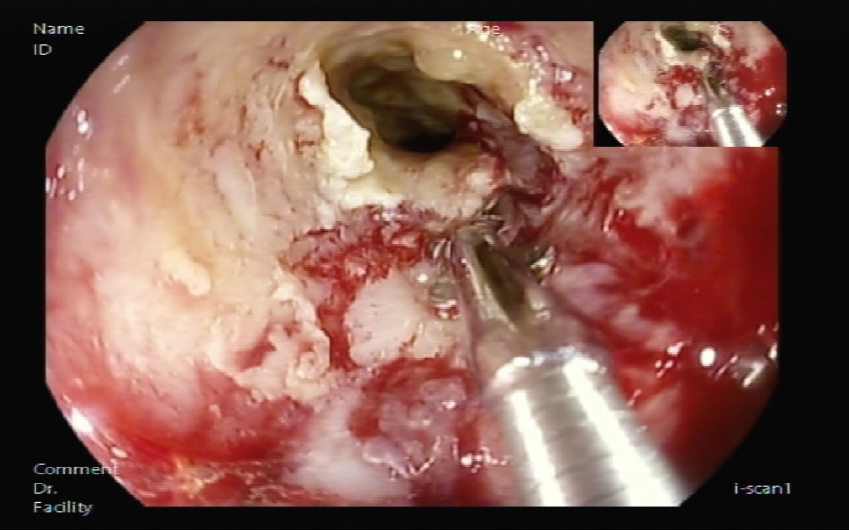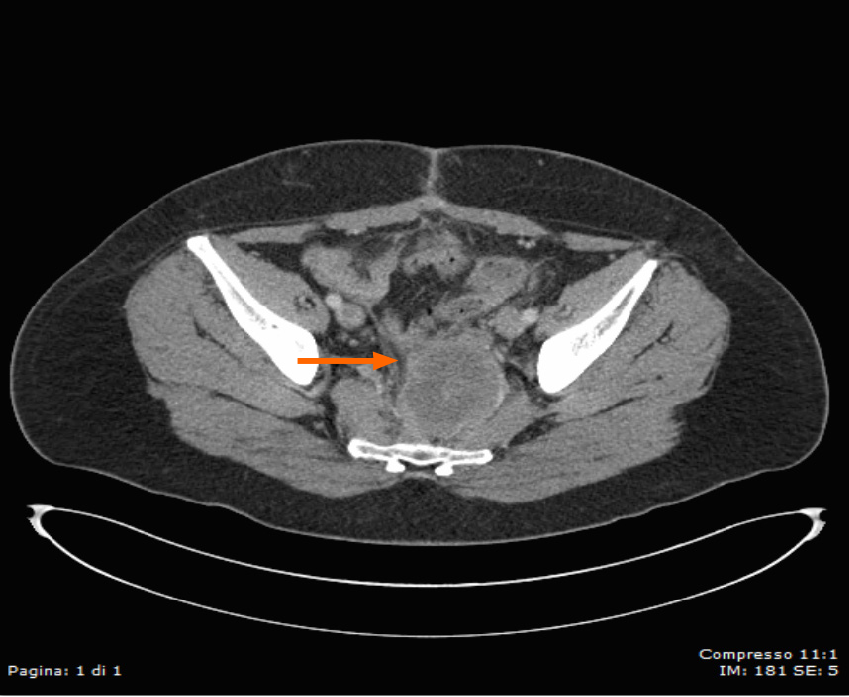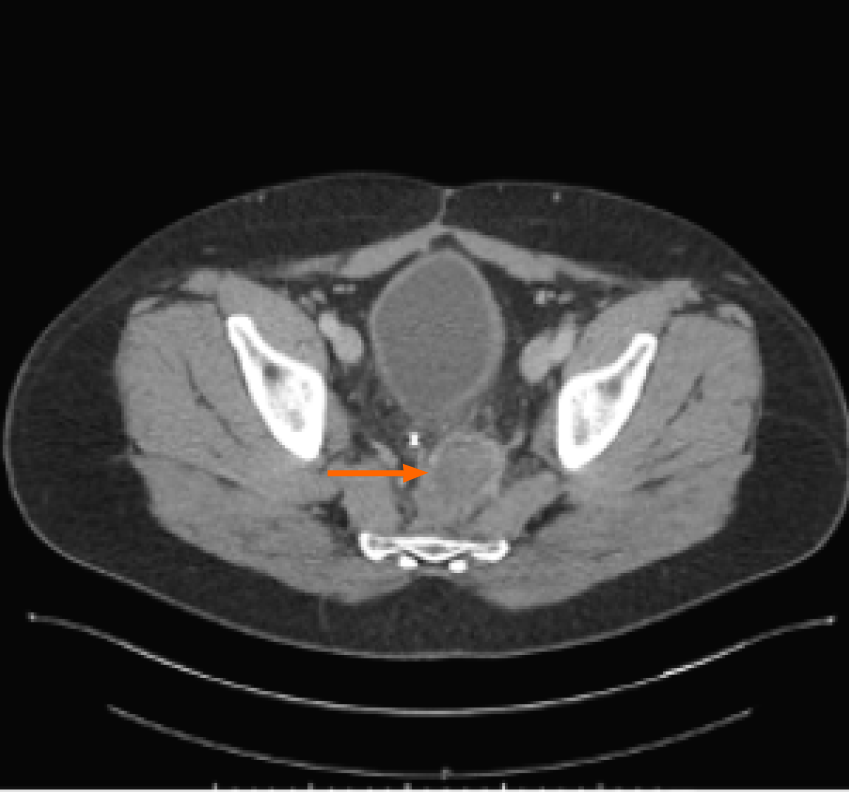Published online Jun 24, 2021. doi: 10.5306/wjco.v12.i6.500
Peer-review started: October 23, 2020
First decision: December 4, 2020
Revised: December 24, 2020
Accepted: March 3, 2021
Article in press: March 3, 2021
Published online: June 24, 2021
Processing time: 240 Days and 19.5 Hours
Neuroendocrine gastrointestinal tumors (NETs) are rare and have different natural behaviors. Surgery is the gold standard treatment for local disease while radiotherapy has been demonstrated to be ineffective. Poorly differentiated neuroendocrine carcinomas (NECs) represent only 5%-10% of digestive NETS. Due to aggressive growth and rapid metastatic diffusion, early diagnosis and a multidisciplinary approach are mandatory. The role of surgery and radiotherapy in this setting is still debated, and chemotherapy remains the treatment of choice.
A 42-year-old male with an ulcerated bleeding rectal lesion was diagnosed with a NEC G3 (Ki67 index > 90%) on May 2015 and initially treated with 3 cycles of first-line chemotherapy, but showed early local progressive disease at 3 mo and underwent sphincter-sparing open anterior low rectal resection. In September 2015, the first post-surgery total-body computed tomography (CT) scan showed an early pelvic disease relapse. Therefore, systemic chemotherapy with FOLFIRI was started and the patient obtained only a partial response. This was followed by pelvic radiotherapy (50 Gy). On April 2016, a CT scan and 18F-fluorodeoxy
This case demonstrates how a multimodal approach can be successful in obtaining long-term CR in metastatic sites in patients with high grade digestive NECs.
Core Tip: Neuroendocrine gastrointestinal tumors are rare with different clinical behaviors. Prognostic factors are tumor differentiation, Ki-67 index and the presence of distant metastases. Most of these tumors are well differentiated neuroendocrine tumors with a good prognosis and a 5-year overall survival of 60%-90%. Surgery is the gold standard treatment in local and metastatic disease, while radiotherapy is ineffective. Poorly differentiated neuroendocrine carcinomas represent only 5%-10% of digestive neuroendocrine gastrointestinal tumors. Here we describe the rare case of a patient diagnosed with poorly differentiated rectal metastatic neuroendocrine carcinoma treated with a different treatment approach and with complete remission after 5 years.
- Citation: Della Torre S, de Nucci G, Lombardi PM, Grandi S, Manes G, Bollina R. Long-term complete response in metastatic poorly-differentiated neuroendocrine rectal carcinoma with a multimodal approach: A case report. World J Clin Oncol 2021; 12(6): 500-506
- URL: https://www.wjgnet.com/2218-4333/full/v12/i6/500.htm
- DOI: https://dx.doi.org/10.5306/wjco.v12.i6.500
Neuroendocrine gastrointestinal tumors (NETs) are rare and have different natural behaviors. Prognostic factors are tumor differentiation, Ki-67 index and the presence of distant metastases. Most of these tumors are well differentiated NETs[1]; even in the presence of metastasis their prognosis is good with a 5-year overall survival (OS) of 60%-90%. Surgery is the gold standard treatment for local disease and often in metastatic cases, while radiotherapy has been demonstrated to be ineffective[2]. Poorly differentiated neuroendocrine carcinomas (NECs) represent only 5%-10% of digestive NETs and among these rectal NECs account for less than 1% of colorectal malig
On May 2015, a 42-year-old male attended our Emergency Department due to acute rectal bleeding.
An urgent colonoscopy showed the presence of an ulcerated lesion 12 cm distant from the anal verge (Figure 1). Endoscopic histological sampling revealed a NEC G3 (Ki67 index > 90%).
He had no previous health problems, only an allergy to nickel.
No familial history of gastrointestinal disease or tumors.
On presentation, his vital signs were temperature of 36.5°C, pulse rate of 115 bpm, respiratory rate of 17 breaths/min, blood pressure of 110/60 mmHg, and oxygen saturation of 95%. On general physical examination he looked pale. Abdominal examination revealed a non-distended abdomen. Cardiovascular, pulmonary and neurological examinations were unremarkable.
Complete blood count analysis revealed a huge decrease in hemoglobin level (9.8 mg/mL) and decreased iron and ferritin levels (20 μg/mL and 4 μg/mL, respectively).
Magnetic resonance imaging (MRI), computed tomography (CT) scan and 18F-fluorodeoxyglucose positron emission tomography/CT (18F-FDG PET/CT) scan confirmed rectal localization with loco-regional lymph node involvement and the absence of metastatic disease. After 3 cycles of first-line chemotherapy with cispla
After a multidisciplinary evaluation, surgery was recommended.
The histopathology report confirmed small-cell poorly-differentiated NEC pT3N1 (6/14), G3, Ki67 98%, with negative surgical margins.
In August 2015, the patient underwent sphincter-sparing open anterior low rectal resection, and fashioning of a colonic terminal stoma.
In September 2015, the first post-surgery total-body CT scan showed early disease relapse with a 85 mm pelvic lesion (Figure 2), without any other disease on 18F-FDG PET/CT. Thus, systemic chemotherapy with FOLFIRI (irinotecan 180 mg/m2 on day 1, followed by folinic acid 400 mg/m2, a 5-FU bolus of 400 mg/m2 and 5-FU 1200 mg/m2 in a 44-h infusion days (1-2 cycles every 14 d), was administered, and a partial response (PR) was obtained after 12 cycles. This was followed by pelvic radiotherapy (50 Gy). On April 2016, CT scan and 18F-FDG PET/CT imaging showed CR of the pelvic lesion, but pathological abdominal inter-aortocaval lymph nodes (Figure 3 and 4). Due to early progression after systemic treatment of abdominal malignant nodes, the patient received radiotherapy at 45 Gy and obtained a CR. He was followed-up with CT scan and 18F-FDG PET/CT every 6 mo. At the last follow-up in January 2021 both examinations confirmed CR in the pelvic and metastatic disease (Figure 5). He had no symptoms and no late toxicity after chemotherapy or radiotherapy.
Rectal NECs are rare entities and there is no consensus on their treatment especially local disease[5]. As there are no guidelines based on prospective studies, oncologists normally use modalities extrapolated from colonic adenocarcinomas or small-cell lung cancer or based on retrospective analysis[6]. The efficacy of systemic chemotherapy for treating digestive metastatic NEC has been largely demonstrated and the role of radiation therapy (RT) and/or surgery is still debated, both in the early stage and metastatic disease[7]. Our case highlights several issues related to the possible clinical treatment of rectal NECs, especially how to treat local primary tumors in patients without metastatic disease. Some retrospective studies agree that there are no differences between surgery and chemoradiotherapy in terms of progression-free survival and OS in local rectal NECs, with disease control in approximately 93% of patients treated exclusively with chemoradiotherapy[8]. These results and the know
In the metastatic setting, the gold standard first-line treatment is the combination of platinum and etoposide[10]. Even if there is a high response rate (60%) with this schedule, median OS is poor, ranging from 10 mo to 15 mo[11]. The role of second-line treatment is debated. Some schedules have been tested, which have also included irinotecan. The use of this drug is suggested due to its efficacy demonstrated in both small-cell lung cancer and in colorectal cancer in several studies[12]. After surgery, to treat local early disease relapse we used second-line chemotherapy with FOLFIRI, as the efficacy of FOLFIRI has already been demonstrated in a French study of 39 patients who failed etoposide and platinum combination[13-15]. After obtaining a PR with systemic treatment, pelvic RT was performed, with a long-term local CR. Two months after the end of second-line chemotherapy, metastatic disease was identified in intra-aortocaval lymph nodes, which showed no response to systemic treatment. The efficacy of radiotherapy in metastatic patients with NECs has been proved in bone and brain metastasis, but there are no data about its use in other metastatic sites[16,17]. An anecdotal approach with radiosurgery was applied with success in one case of visceral metastasis from rectal MANEC (Mixed Adenoneuroendocrine Carcinoma). Consi
Our case demonstrates how a multimodal approach and continuous follow-up restaging can be successful in obtaining a long-term CR in local and metastatic sites; thus, improving 5-year survival in patients with high grade digestive NEC as confirmed by the last total body CT scan in January 2021 in our patient. Therefore, based on our experience, chemotherapy, RT and surgery should be considered together in the management of rectal NEC even in presence of systemic spread. The treatment for each patient, in the absence of prospective studies and considering the rarity of the disease, need to be accurately tailored.
Manuscript source: Unsolicited manuscript
Corresponding Author's Membership in Professional Societies: Società Italiana Di Gastroenterologia Ed Endoscopia Digestiva, No. 01723.
Specialty type: Medicine, research and experimental
Country/Territory of origin: Italy
Peer-review report’s scientific quality classification
Grade A (Excellent): 0
Grade B (Very good): 0
Grade C (Good): C
Grade D (Fair): 0
Grade E (Poor): 0
P-Reviewer: Merkel S S-Editor: Gao CC L-Editor: Webster JR P-Editor: Yuan YY
| 1. | Hentic O, Couvelard A, Rebours V, Zappa M, Dokmak S, Hammel P, Maire F, O’Toole D, Lévy P, Sauvanet A, Ruszniewski P. Ki-67 index, tumor differentiation, and extent of liver involvement are independent prognostic factors in patients with liver metastases of digestive endocrine carcinomas. Endocr Relat Cancer. 2011;18:51-59. [RCA] [PubMed] [DOI] [Full Text] [Cited by in Crossref: 51] [Cited by in RCA: 56] [Article Influence: 4.0] [Reference Citation Analysis (0)] |
| 2. | Bertani E, Ravizza D, Milione M, Massironi S, Grana CM, Zerini D, Piccioli AN, Spinoglio G, Fazio N. Neuroendocrine neoplasms of rectum: A management update. Cancer Treat Rev. 2018;66:45-55. [RCA] [PubMed] [DOI] [Full Text] [Cited by in Crossref: 55] [Cited by in RCA: 59] [Article Influence: 8.4] [Reference Citation Analysis (2)] |
| 3. | Bernick PE, Klimstra DS, Shia J, Minsky B, Saltz L, Shi W, Thaler H, Guillem J, Paty P, Cohen AM, Wong WD. Neuroendocrine carcinomas of the colon and rectum. Dis Colon Rectum. 2004;47:163-169. [RCA] [PubMed] [DOI] [Full Text] [Cited by in Crossref: 236] [Cited by in RCA: 212] [Article Influence: 10.1] [Reference Citation Analysis (0)] |
| 4. | Shafqat H, Ali S, Salhab M, Olszewski AJ. Survival of patients with neuroendocrine carcinoma of the colon and rectum: a population-based analysis. Dis Colon Rectum. 2015;58:294-303. [RCA] [PubMed] [DOI] [Full Text] [Cited by in Crossref: 68] [Cited by in RCA: 71] [Article Influence: 7.1] [Reference Citation Analysis (0)] |
| 5. | Garcia-Carbonero R, Sorbye H, Baudin E, Raymond E, Wiedenmann B, Niederle B, Sedlackova E, Toumpanakis C, Anlauf M, Cwikla JB, Caplin M, O’Toole D, Perren A; Vienna Consensus Conference participants. ENETS Consensus Guidelines for High-Grade Gastroenteropancreatic Neuroendocrine Tumors and Neuroendocrine Carcinomas. Neuroendocrinology. 2016;103:186-194. [RCA] [PubMed] [DOI] [Full Text] [Cited by in Crossref: 382] [Cited by in RCA: 419] [Article Influence: 46.6] [Reference Citation Analysis (0)] |
| 6. | Mitry E, Baudin E, Ducreux M, Sabourin JC, Rufié P, Aparicio T, Lasser P, Elias D, Duvillard P, Schlumberger M, Rougier P. Treatment of poorly differentiated neuroendocrine tumours with etoposide and cisplatin. Br J Cancer. 1999;81:1351-1355. [RCA] [PubMed] [DOI] [Full Text] [Full Text (PDF)] [Cited by in Crossref: 347] [Cited by in RCA: 348] [Article Influence: 13.4] [Reference Citation Analysis (0)] |
| 7. | Sorbye H, Welin S, Langer SW, Vestermark LW, Holt N, Osterlund P, Dueland S, Hofsli E, Guren MG, Ohrling K, Birkemeyer E, Thiis-Evensen E, Biagini M, Gronbaek H, Soveri LM, Olsen IH, Federspiel B, Assmus J, Janson ET, Knigge U. Predictive and prognostic factors for treatment and survival in 305 patients with advanced gastrointestinal neuroendocrine carcinoma (WHO G3): the NORDIC NEC study. Ann Oncol. 2013;24:152-160. [RCA] [PubMed] [DOI] [Full Text] [Cited by in Crossref: 601] [Cited by in RCA: 709] [Article Influence: 54.5] [Reference Citation Analysis (0)] |
| 8. | Brieau B, Lepère C, Walter T, Lecomte T, Guimbaud R, Manfredi S, Tougeron D, Desseigne F, Lourenco N, Afchain P, El Hajbi F, Terris B, Rougier P, Coriat R. Radiochemotherapy Versus Surgery in Nonmetastatic Anorectal Neuroendocrine Carcinoma: A Multicenter Study by the Association des Gastro-Entérologues Oncologues. Medicine (Baltimore). 2015;94:e1864. [RCA] [PubMed] [DOI] [Full Text] [Full Text (PDF)] [Cited by in Crossref: 23] [Cited by in RCA: 24] [Article Influence: 2.4] [Reference Citation Analysis (0)] |
| 9. | Smith JD, Reidy DL, Goodman KA, Shia J, Nash GM. A retrospective review of 126 high-grade neuroendocrine carcinomas of the colon and rectum. Ann Surg Oncol. 2014;21:2956-2962. [RCA] [PubMed] [DOI] [Full Text] [Cited by in Crossref: 93] [Cited by in RCA: 102] [Article Influence: 9.3] [Reference Citation Analysis (0)] |
| 10. | Alese OB, Jiang R, Shaib W, Wu C, Akce M, Behera M, El-Rayes BF. High-Grade Gastrointestinal Neuroendocrine Carcinoma Management and Outcomes: A National Cancer Database Study. Oncologist. 2019;24:911-920. [RCA] [PubMed] [DOI] [Full Text] [Cited by in Crossref: 17] [Cited by in RCA: 42] [Article Influence: 6.0] [Reference Citation Analysis (0)] |
| 11. | Fjällskog ML, Granberg DP, Welin SL, Eriksson C, Oberg KE, Janson ET, Eriksson BK. Treatment with cisplatin and etoposide in patients with neuroendocrine tumors. Cancer. 2001;92:1101-1107. [RCA] [PubMed] [DOI] [Full Text] [Cited by in RCA: 2] [Reference Citation Analysis (0)] |
| 12. | Noda K, Nishiwaki Y, Kawahara M, Negoro S, Sugiura T, Yokoyama A, Fukuoka M, Mori K, Watanabe K, Tamura T, Yamamoto S, Saijo N; Japan Clinical Oncology Group. Irinotecan plus cisplatin compared with etoposide plus cisplatin for extensive small-cell lung cancer. N Engl J Med. 2002;346:85-91. [RCA] [PubMed] [DOI] [Full Text] [Cited by in Crossref: 1035] [Cited by in RCA: 946] [Article Influence: 41.1] [Reference Citation Analysis (0)] |
| 13. | Cunningham D, Pyrhönen S, James RD, Punt CJ, Hickish TF, Heikkila R, Johannesen TB, Starkhammar H, Topham CA, Awad L, Jacques C, Herait P. Randomised trial of irinotecan plus supportive care versus supportive care alone after fluorouracil failure for patients with metastatic colorectal cancer. Lancet. 1998;352:1413-1418. [RCA] [PubMed] [DOI] [Full Text] [Cited by in Crossref: 946] [Cited by in RCA: 888] [Article Influence: 32.9] [Reference Citation Analysis (0)] |
| 14. | Hentic O, Hammel P, Couvelard A, Rebours V, Zappa M, Palazzo M, Maire F, Goujon G, Gillet A, Lévy P, Ruszniewski P. FOLFIRI regimen: an effective second-line chemotherapy after failure of etoposide-platinum combination in patients with neuroendocrine carcinomas grade 3. Endocr Relat Cancer. 2012;19:751-757. [RCA] [PubMed] [DOI] [Full Text] [Cited by in Crossref: 107] [Cited by in RCA: 126] [Article Influence: 9.7] [Reference Citation Analysis (0)] |
| 15. | Radu EC, Saizu AI, Grigorescu RR, Croitoru AE, Gheorghe C. Metastatic neuroendocrine pancreatic tumor - Case report. J Med Life. 2018;11:57-61. [PubMed] |
| 16. | Zhao Y, Castonguay M, Wilke D, Xu Z, Plourde M, Mulroy L, MacNeil M, Bowes D. Treatment outcomes and incidence of brain metastases in pulmonary large cell neuroendocrine carcinoma. Curr Probl Cancer. 2019;43:54-65. [RCA] [PubMed] [DOI] [Full Text] [Cited by in Crossref: 13] [Cited by in RCA: 17] [Article Influence: 2.4] [Reference Citation Analysis (0)] |
| 17. | Semrau S, Agaimy A, Pavel M, Lubgan D, Schmidt D, Cavallaro A, Golcher H, Grützmann R, Fietkau R. Long-term control with chemoradiation of initially metastatic mixed adenoneuroendocrine carcinoma of the rectum: a case report. J Med Case Rep. 2019;13:82. [RCA] [PubMed] [DOI] [Full Text] [Full Text (PDF)] [Cited by in Crossref: 8] [Cited by in RCA: 8] [Article Influence: 1.3] [Reference Citation Analysis (0)] |













